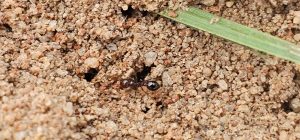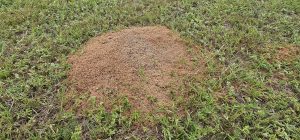The warm Florida climate makes it a biologically diverse place, with plants and animals from all over the world finding a foothold here. Some are benign, while others can become pests that harm the environment or get in the way of human activities. One such pest is the red imported fire ant, a visitor from South America. Introduced to North America somewhere in the 1930s or 1940s, these ants are native to a region of savannas and wetlands, where the rainy season brings flooding part of the year. Finding a similar climate along the Gulf coast after hitching a ride on ships, what these ants did NOT find were predators that could keep their populations in check. They have since spread throughout the southeast, and are predicted to make their way up the east coast as far as Maryland, west into Texas before it becomes too dry for them to live comfortably, and even along the Pacific coast of the United States.
Though they are called ‘red’, their coloration is often reddish-brown with a darker abdomen. Populations in different areas may vary in their particular shade of color. They range in size from 1/8 to ¼ inch in length. A characteristic identifier for this species of ant is their mounds. These are not just regular anthills, where workers digging tunnels belowground dump grains of soil in a pile. Fire ant mounds help the colony regulate temperatures and moisture levels. They are often constructed in open, sunny locations. Disturbing a mound will cause the ants within it to swarm, with hundreds of ants suddenly ready to sting anything around. Their sting usually leaves a white pustule on the skin, coupled with an intense burning or itching sensation. Being attacked by fire ants is one of the least fun things you can do in a garden or landscape.
How do we get rid of fire ants? It is important to understand that fire ants don’t live alone. They are dependent on their colony, where workers forage for food, soldiers protect the nest, and the queen (or queens – fire ant nests have been known to have multiple queens) lays eggs. The queen remains sheltered inside the nest, and until she is gone, the nest can replace its workers. Therefore, any treatment must effectively remove the queen.
Home remedies are often ineffective. Pouring boiling water over ant mounds can damage the colony, but may not reach deep enough into the mound to kill the queen. Applying dry grits to a mound will not harm the ants. Other remedies, such as club soda, simply do not work, and while gasoline and other harsh chemicals might kill some ants, they are not guaranteed to kill the queen. They are likely to cause contamination of the groundwater, however.
What are effective are insecticides, formulated as baits or mound drenches or treatments. Baits are taken by the workers back into the nest, where they are fed to the queen. Mound treatments, when properly applied, soak into the mound and are able to penetrate deeply enough to eliminate the colony. Read the label of any product you choose carefully and follow the instructions.
For more information, see our EDIS fact sheet here:
ENY226/LH059: Managing Imported Fire Ants in Urban Areas
Evan Anderson
Walton County Horticulture Agent
- Quercus Geminata, the Sand Live Oak - November 20, 2025
- Snakes of the Panhandle - October 10, 2025
- Ganoderma, a Deadly Disease of Palms - September 4, 2025


